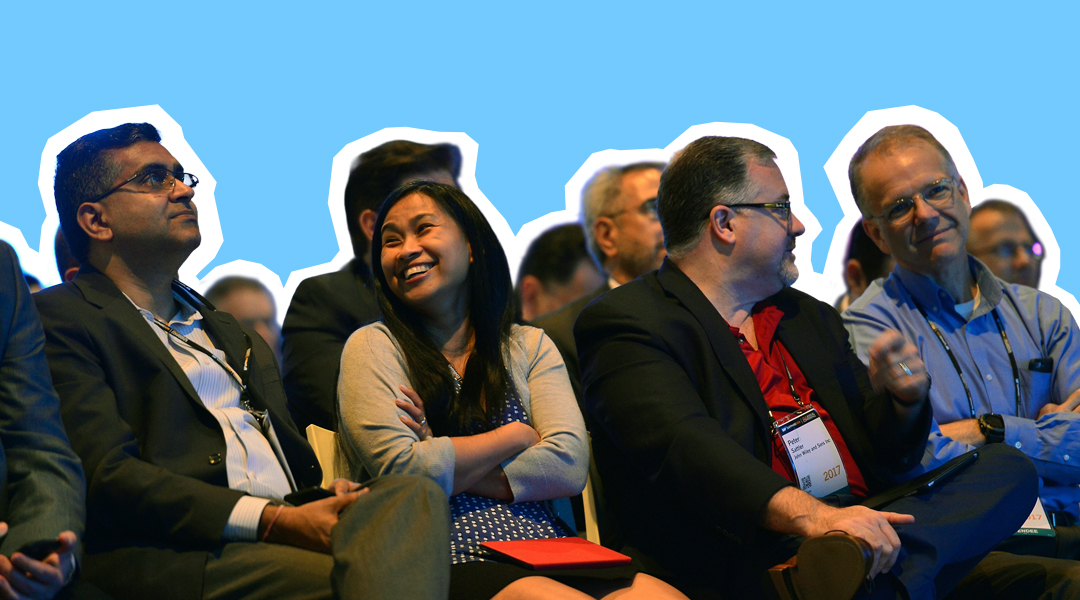Blog: Event management
How PCOs can leverage the right event technology to win more association business
30 September 2025 minute read

Life’s tough in the aluminium-siding business, sure. But is it any tougher than being a Professional Conference Organiser (PCO)?
Winning and retaining association clients is more competitive than it’s ever been for PCOs. Associations and learned societies are under pressure to deliver seamless delegate experiences, demonstrate measurable value to members, and justify every euro or dollar spent on conferences. They are looking for partners who not only manage logistics but can also bring digital innovation, data insight, and marketing excellence to the table.
For PCOs, the choices they make around event technology are central to that proposition. The right platform doesn’t just help an event run smoothly – it shows clients that you understand their world, can handle complexity at scale, and can deliver the reporting and transparency they demand.
In short, technology has become one of the most powerful differentiators a PCO has at their disposal. Here’s how to use it to win more association business.
1 Offer a seamless, integrated experience
When associations issue RFPs, they’re often wary of fragmented systems: one provider for registration, another for the mobile app, another for virtual, badging and so on. Fragmentation leads to errors, duplication, and frustrating user experiences for delegates, staff, sponsors and other stakeholders.
By contrast, PCOs that propose integrated, end-to-end platforms – covering everything from call-for-papers to post-event analytics – send a strong message about professionalism and efficiency. Unified systems allow:
- Abstract data to flow directly into the programme builder.
- Session updates to sync automatically with websites and apps.
- Registrations, payments, and attendance to be tracked in a single database.
For an association, this means fewer vendors to manage and cleaner data throughout the event lifecycle. For a PCO, it means a more scalable business model and a stronger pitch: ‘We can deliver a fully connected digital experience from submission to session.’
2 Showcase leadership in scientific content management
Academic and research-based associations are judged on conference quality by the rigour of their peer-review process. A PCO that can demonstrate mastery of abstract and review management technology instantly earns credibility.
So, consider using a specialist peer-review system to manage paper evaluation and selection as these dedicated tools will be more configurable.
The critical issue is then how you get the list of accepted submissions (along with the abstract, details of multiple authors, keyword tags and more) into your event platform.
The right integration is key here. Your event platform should be sophisticated enough to accept the kind of complex, structured data associated with scientific and technical papers and render it directly into the agenda on your website, attendee app and elsewhere.
No cutting and pasting. No wasted effort. No mistakes.
Just a direct integration between accepted abstracts and the session programme.
By highlighting these capabilities in a proposal, PCOs can reassure clients that scientific integrity and administrative efficiency are equally protected. It signals: ‘We understand how your community works – and we’ve invested in the tools to support it’.
3 Turn programme complexity into a selling point
Large academic congresses often feature dozens of parallel sessions, hundreds of speakers and numerous session formats. Many associations find programme management overwhelming, and few event platforms support complex agendas at all.
This is where technology can transform a headache into a differentiator. When pitching, show that your team uses:
- Dynamic, drag-and-drop agenda builders for multi-track scheduling.
- Fully configurable session types – where multiple properties (author affiliations, roles, abstracts, titles, etc) can be prescribed as needed for consistency.
- Real-time publishing of agenda data directly to front-end websites and attendee apps.
- Conflict detection to prevent double-booking speakers or rooms.
- Automatic linking between abstracts, sessions, and speakers.
Demonstrating that you can build and update a complex scientific programme in real time – without endless spreadsheets or linking back-and-forth between disparate tools – gives clients confidence that their content will be presented with precision and professionalism.

4 Simplify pricing and registration complexities
Associations frequently grapple with nuanced pricing: members vs non-members; public sector vs private; students, low-income countries, early-bird tiers, complimentary passes for reviewers, speakers and sponsors … Handling this manually invites mistakes and creates a headache for attendees and teams.
Too often, you end up sticking a hundred different prices into a table and asking the customer to work out their price from that. And too often that table ends up being roughly the size of the one Vladimir Putin has in his office in the Kremlin.
PCOs can stand out by offering a registration platform that automates complex pricing rules while integrating directly with association membership databases. During proposals, emphasise:
- Dynamic pricing logic and membership validation.
- Smart group and institutional registration options.
- Separate secure pathways for complimentary registrations.
- Multi-currency and tax compliance.
This not only demonstrates operational competence but also helps associations achieve their goals of inclusivity and transparency. For the PCO, it means fewer manual adjustments and cleaner financial reconciliation – both strong selling points.
Most importantly of all, it reduces friction and maximises the percentage of completed registrations.
5 Position engagement tools as value for members
For associations, conferences are not just about logistics – they are about member engagement, knowledge exchange, and community building. PCOs who can use technology to enhance these goals are far more likely to secure repeat business.
Highlight how your chosen tools:
- Create personalised delegate journeys with mobile apps and recommendation engines.
- Enable interactive sessions through live polling, Q&A, and chat.
- Support digital poster galleries and searchable abstract libraries.
- Encourage networking with with P2P direct messaging.
- Extend the life of content through on-demand access after the event.
Position these features not as ‘add-ons’ but as strategic benefits: ‘Our technology helps your members connect, share research, and engage long after the closing ceremony’.
That’s a value proposition any membership-based organisation will find compelling.
6 Deliver measurable impact for sponsors and exhibitors
Sponsors are a vital revenue source for most associations. The more value a PCO can demonstrate for sponsors, the more likely the association will trust them with future events.
When pitching, show how your technology supports:
- Easy management of sponsor profiles, logos, materials, and entitlements across all touchpoints.
- Lead retrieval and analytics for in-person and virtual booths.
- Branded sponsor recognition within mobile apps or virtual environments.
- Post-event performance reporting that quantifies sponsor visibility and engagement.
If you can hand sponsors a clear, data-driven report of who engaged with their content, your association clients will see measurable ROI – and you’ll be seen as a partner who delivers commercial sustainability alongside academic excellence.

7 Demonstrate operational excellence on-site
When delegates arrive, every touchpoint reflects on both the association and the PCO. Slow check-ins or badge errors can undermine months of planning.
PCOs can differentiate themselves by offering reliable, data-connected on-site systems:
- Fast, self-service check-in and badge printing.
- Real-time attendance tracking and access control.
- Integration with the registration and session data.
- Offline backup to ensure continuity.
Being able to tell a prospective client, ‘We can check in 1,000 delegates in under 15 minutes’ is a simple but powerful statement. It shows control, preparation, and technological competence – the hallmarks of a professional organiser.
Traditionally, a PCO would need to find an additional $20–30k in the budget to pay a badging company to provide this technology. But choose the right platform partner and they should have cutting edge check-in apps and fast on-demand badge printing capabilities as part of their technology stack.
8 Use data and reporting to strengthen client relationships
Post-event analytics are where PCOs can truly distinguish themselves from competitors. Associations crave data to understand delegate demographics, engagement patterns, and session popularity – yet a surprising number of events still rely on anecdotal feedback.
With the right technology, PCOs can deliver comprehensive, visualised reporting dashboards that highlight:
- Submission and acceptance trends.
- Attendance by track, region, and member category.
- Sponsor exposure and engagement metrics.
- Financial summaries and ROI indicators.
Sharing these insights not only fulfils reporting obligations but also positions the PCO as a strategic advisor rather than simply a logistics provider. It gives you powerful follow-up material for the next bid: ‘Here’s what we learned, and here’s how we’ll improve your next event’.

9 Build trust through compliance and accessibility
Academic and not-for-profit associations take data protection, ethics, and inclusivity seriously. PCOs who demonstrate attention to these details earn trust faster.
Choose and promote technologies that meet:
- GDPR and global privacy standards
- Accessibility compliance (WCAG 2.1)
- Role-based permissions and 2FA
When you can show that your systems protect participant data and ensure equitable access, you reinforce your reputation as a responsible partner – an increasingly decisive factor in RFP evaluations.
10 Use technology as a strategic differentiator
Ultimately, the right event technology is not just an operational tool – it’s a business growth engine. It helps PCOs:
- Win new contracts through demonstrable digital capability.
- Reduce costs and manual workload.
- Deliver consistent quality across multiple clients.
- Strengthen long-term relationships through transparency and insight.
In your pitches, make technology part of the story: not just what software you use, but how it empowers associations to achieve their mission more effectively. Frame your offering as partnership-oriented: ‘We combine human expertise with best-in-class technology to deliver flawless, data-rich, member-centric conferences’.
In the academic and association world, expectations have changed. Efficiency, engagement, inclusivity, and data are now non-negotiable. Associations want to work with PCOs who can deliver all four – reliably, securely, and at scale.
By working with the right event technology platform, PCOs can do more than streamline operations; they can transform how clients perceive their value. A technology-enabled PCO is no longer just a service provider – they’re a trusted partner in advancing science, research, and professional collaboration.
When every bid counts, your technology stack is not a back-office choice. It’s your business card, your differentiator, and your pathway to winning the next generation of association clients.



